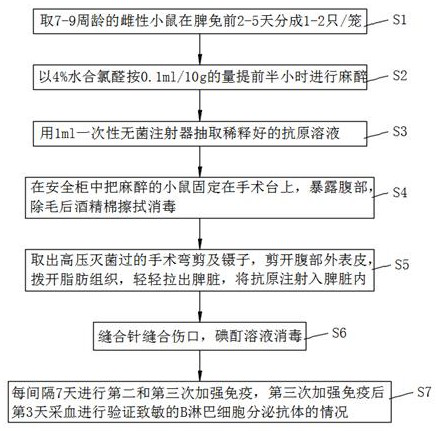Method for preparing monoclonal antibody through rapid immunization
A monoclonal antibody and rapid immunization technology, applied in the field of IVD diagnosis, can solve the problems of cumbersome and time-consuming operations, affecting antibody titers, and long immunization cycles, and achieve simple immunization operations, increased antibody titers, and low antigen usage Effect
- Summary
- Abstract
- Description
- Claims
- Application Information
AI Technical Summary
Problems solved by technology
Method used
Image
Examples
Embodiment Construction
[0028] The following will clearly and completely describe the technical solutions in the embodiments of the present invention in conjunction with the accompanying drawings in the embodiments of the present invention; obviously, the described embodiments are only part of the embodiments of the present invention, not all embodiments, based on The embodiments of the present invention and all other embodiments obtained by persons of ordinary skill in the art without making creative efforts belong to the protection scope of the present invention.
[0029] The present invention provides a technical solution: please refer to figure 1 , a method for preparing monoclonal antibody rapid immunization, comprising the following steps:
[0030] Step 1. Among the cultured female mice, 7-9 week-old female mice are taken and divided into cages, with 1-2 mice in each cage.
[0031] Step 2: Anesthetize the caged female mice with 4% chloral hydrate in an amount of 0.1ml / 10g.
[0032] Step 3: Dr...
PUM
 Login to View More
Login to View More Abstract
Description
Claims
Application Information
 Login to View More
Login to View More - R&D
- Intellectual Property
- Life Sciences
- Materials
- Tech Scout
- Unparalleled Data Quality
- Higher Quality Content
- 60% Fewer Hallucinations
Browse by: Latest US Patents, China's latest patents, Technical Efficacy Thesaurus, Application Domain, Technology Topic, Popular Technical Reports.
© 2025 PatSnap. All rights reserved.Legal|Privacy policy|Modern Slavery Act Transparency Statement|Sitemap|About US| Contact US: help@patsnap.com

